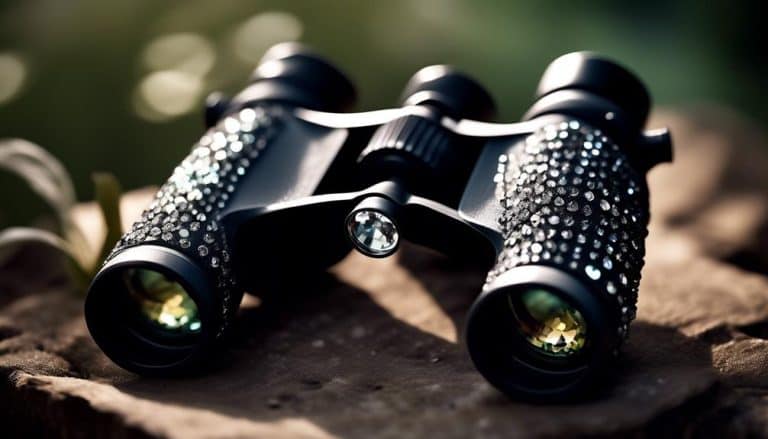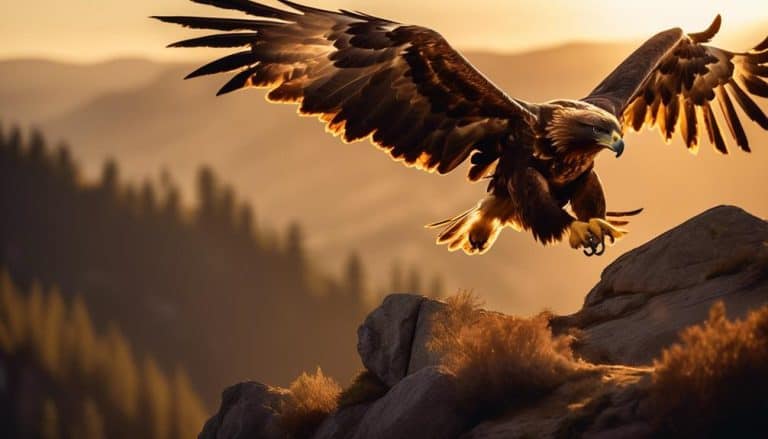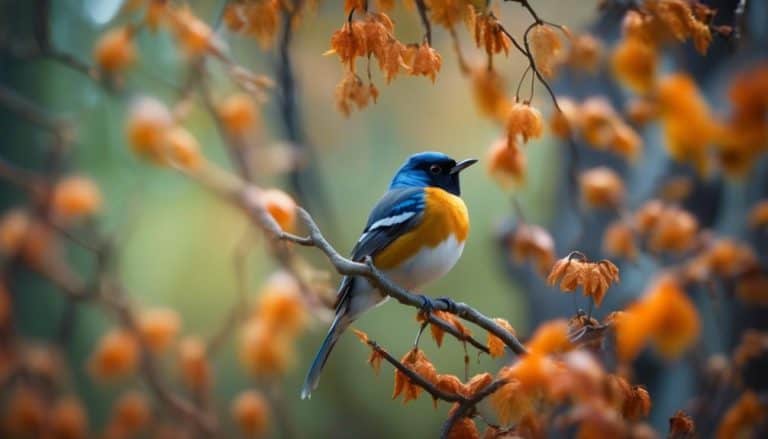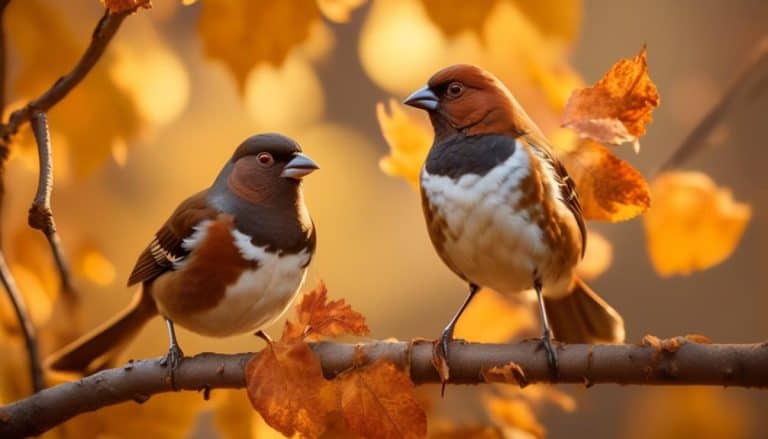As I step into the enchanting world of Wisconsin's small birds, I am captivated by the kaleidoscope of colors and melodies that fill the air.
These delicate creatures, like hidden gems amidst a sea of green, hold secrets and stories waiting to be discovered.
From the bold and beautiful Blue Jay to the tiny charmer, the Black-capped Chickadee, each bird has its own unique allure.
Join me as we embark on a journey through the vibrant landscapes of Wisconsin, where we will encounter the sunshine yellow songbird, the American Goldfinch, and the symbol of happiness, the Eastern Bluebird.
But that's not all, for there are more tales to unravel, such as the acrobatics of the White-breasted Nuthatch and the iridescent beauty of the Ruby-throated Hummingbird.
So, come along and let us explore the captivating world of small birds in Wisconsin, where wonders await at every turn.
Blue Jay – The Bold and Beautiful Bird
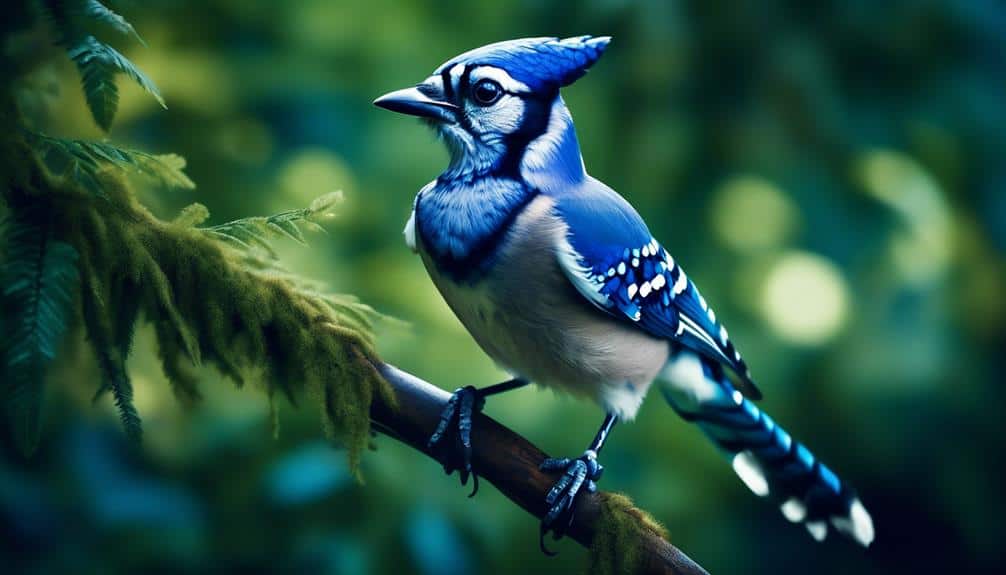
The Blue Jay, with its striking blue feathers and bold personality, is a captivating avian species found in the state of Wisconsin. These intelligent birds are known for their remarkable problem-solving skills, which contribute to their survival in the face of various challenges. Blue Jays have the ability to mimic the calls of other birds, allowing them to deceive predators and protect their nests. Their intelligence also extends to their foraging habits, as they're skilled at finding and storing food for later consumption. This adaptability is crucial, especially considering the impact of habitat loss on their population.
Unfortunately, the Blue Jay population in Wisconsin has been affected by habitat loss. Human activities, such as deforestation and urbanization, have resulted in the destruction of their natural habitats. As a result, these birds have less access to the resources they need to survive, including food and nesting sites. Additionally, the loss of habitat forces Blue Jays to compete with other bird species for limited resources, further impacting their population numbers.
American Goldfinch – The Sunshine Yellow Songbird

Having discussed the challenges faced by the Blue Jay population in Wisconsin, let's now turn our attention to the American Goldfinch, a delightful songbird adorned in vibrant shades of sunshine yellow.
The American Goldfinch, also known as Spinus tristis, is a small passerine bird commonly found in Wisconsin. Here are four interesting facts about this beautiful bird:
- Bird migration: The American Goldfinch is known for its unique migration pattern. Unlike many other bird species, they don't migrate during the breeding season. Instead, they undertake a late summer migration, moving southward in flocks during the fall. This migration helps them find abundant food sources and suitable habitats for the winter months.
- Feeding habits: The American Goldfinch has a specialized diet, primarily consisting of seeds. They've a strong preference for thistle seeds and are well-adapted to extract them from the seed heads using their pointed bills. These birds are also known to feed on dandelion seeds and various other weed seeds, making them valuable in controlling weed populations.
- Distinctive plumage: One of the most striking features of the American Goldfinch is its vibrant plumage. During the breeding season, the males sport a brilliant yellow color, resembling a ray of sunshine. In contrast, the females display a more subdued olive-green coloration. This color difference helps them camouflage themselves while nesting.
- Adaptable nesting behavior: American Goldfinches exhibit a unique nesting behavior. They delay nesting until late June or early July when the peak availability of seeds coincides with the breeding season. This adaptation allows them to provide their young with a diet rich in seeds, ensuring their optimal growth and development.
Black-capped Chickadee – The Tiny Charmer
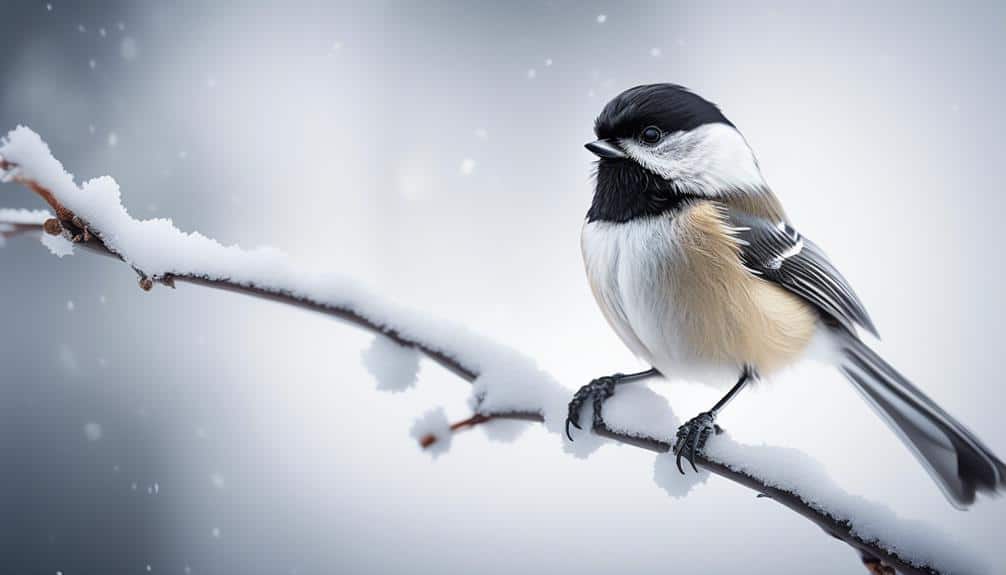
Black-capped Chickadee, a small and charming bird, captivates with its distinctive markings and delightful song. This tiny charmer, known scientifically as Poecile atricapillus, is a common sight in the woodlands and backyards of Wisconsin. With its black cap and bib, white cheeks, and grayish-brown back, it stands out among other birds.
Feeding habits are an important aspect of the black-capped chickadee's behavior. These birds have a diverse diet, consisting of insects, seeds, berries, and even small fruits. They're known for their acrobatic foraging techniques, often hanging upside down from tree branches to reach hidden insect larvae. Their small size and agile movements allow them to explore various food sources efficiently.
Apart from their distinctive appearance and feeding habits, black-capped chickadees are also famous for their vocalizations. Their calls and songs are a melodious combination of whistles, trills, and chirps. The most well-known vocalization is their namesake 'chick-a-dee-dee-dee' song, which serves as a form of communication among flock members. This song is used to establish territory, warn of predators, and maintain social cohesion within the group.
Ruby-throated Hummingbird – The Jewel of Wisconsin

With its iridescent plumage and rapid wing beats, the Ruby-throated Hummingbird is a captivating sight in the lush landscapes of Wisconsin. As a passionate birdwatcher, I've had the privilege of observing these exquisite creatures up close and have marveled at their unique characteristics. Here are four fascinating facts about the Ruby-throated Hummingbird:
- Migration Patterns: Ruby-throated Hummingbirds undertake an incredible migration journey each year. They travel from their breeding grounds in Wisconsin to as far south as Central America. These tiny birds navigate over vast distances, relying on their exceptional memory and instinct to find their way back to their favorite feeding spots.
- Brilliant Plumage: The males of this species boast a vibrant ruby-red throat, which glistens in the sunlight. This striking feature is used to attract females during courtship displays. The rest of their body is a shimmering emerald green, providing excellent camouflage among the foliage.
- Hovering Ability: Ruby-throated Hummingbirds have an extraordinary ability to hover in mid-air. Their rapid wing beats allow them to remain stationary while they extract nectar from flowers or catch tiny insects on the wing. This unique skill sets them apart from other bird species.
- Energetic Metabolism: These hummingbirds have an incredibly high metabolism to sustain their rapid wing beats, which can reach up to 80 times per second. To fuel their energy needs, they consume copious amounts of nectar and insects daily, often visiting hundreds of flowers in a single day.
Observing the Ruby-throated Hummingbird is truly a privilege. Their dazzling beauty, impressive migration patterns, and unique characteristics make them a true jewel of Wisconsin's avian population.
Eastern Bluebird – The Symbol of Happiness

The Eastern Bluebird, a symbol of happiness, is a captivating bird species found in the beautiful landscapes of Wisconsin. Known for its vibrant blue plumage, the Eastern Bluebird holds a symbolic meaning of joy and contentment.
These birds prefer open habitats with scattered trees and shrubs, such as meadows, pastures, and parklands. The availability of nesting cavities is crucial for their survival, and they often rely on man-made nest boxes for breeding. Eastern Bluebirds are social creatures and form small family groups during the breeding season.
In terms of behavior, these birds are primarily insectivorous, feeding on a variety of insects, spiders, and other small invertebrates. They perch on low branches, scanning the ground for prey before swooping down to catch it. The Eastern Bluebird has a distinctive song, consisting of a series of soft warbles and melodious whistles, which they use for communication and territorial defense.
During the breeding season, the male Eastern Bluebird displays courtship behaviors, such as fluttering wings and offering food to the female. They're monogamous and often mate for life. The female builds the nest inside a suitable cavity, lining it with grasses and feathers. Both parents take turns incubating the eggs and feeding the chicks.
The Eastern Bluebird is a delightful addition to the avian diversity of Wisconsin, bringing joy and happiness to those who have the privilege of observing them in their natural habitat.
White-breasted Nuthatch – The Upside-Down Acrobat
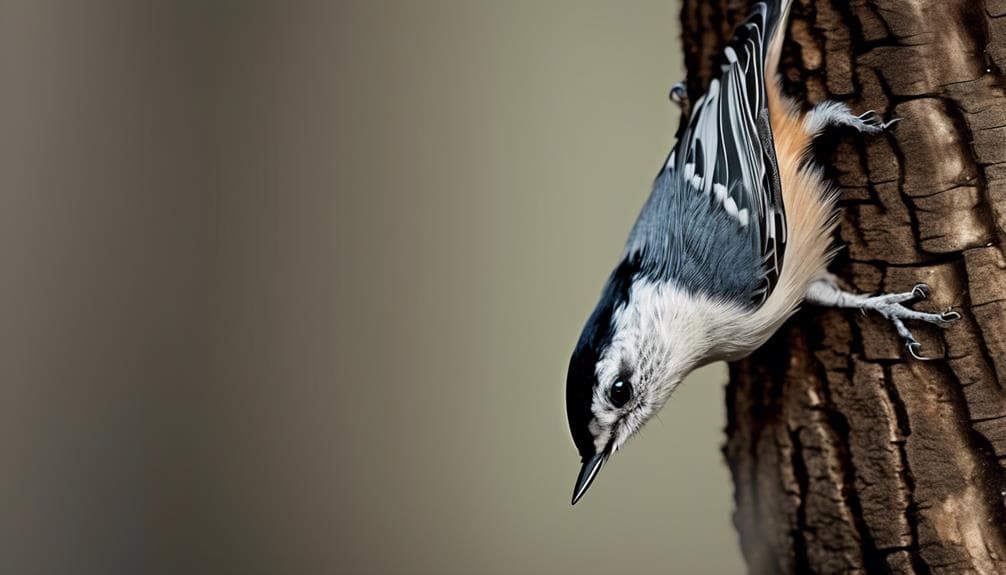
Observing the White-breasted Nuthatch, an acrobatic bird that effortlessly moves upside-down along tree trunks, provides a fascinating insight into the remarkable adaptability and agility of this species. The White-breasted Nuthatch is renowned for its unique feeding habits and its ability to navigate trees in a way that seems to defy gravity.
Here are four intriguing aspects of the White-breasted Nuthatch's upside-down acrobatics and unique feeding habits:
- Vertical foraging: The White-breasted Nuthatch is well-known for its ability to traverse tree trunks headfirst while searching for food. It uses its strong claws and sharp beak to cling to the bark, allowing it to explore every nook and cranny for insects, spiders, and seeds.
- Upside-down feeding: One of the most captivating behaviors of the White-breasted Nuthatch is its ability to feed while hanging upside down. It effortlessly moves along branches and trunks, using its strong legs and agile body to maintain its inverted position as it pecks at insects and seeds.
- Bark scaling: To access hidden food sources, the White-breasted Nuthatch often scales the bark of trees, moving in a spiral pattern as it taps its bill against the surface. This tapping behavior helps it locate insects and grubs that may be hiding beneath the bark.
- Food storage: In preparation for the colder months, the White-breasted Nuthatch has a unique habit of caching food. It collects seeds and stores them in crevices or bark furrows, creating a hidden supply of sustenance to sustain itself during periods of scarcity.
The White-breasted Nuthatch's upside-down acrobatics and unique feeding habits are a testament to its remarkable adaptability and resourcefulness. Its ability to navigate trees with such agility and precision is truly a marvel to behold.
Frequently Asked Questions
How Do These Small Birds Migrate During the Winter Months?
During the winter months, small birds migrate to warmer regions to ensure their survival. They follow established migration patterns and employ various strategies to find food and shelter in order to endure the harsh conditions.
Are There Any Specific Plants or Flowers That Attract These Small Birds to Gardens in Wisconsin?
I've observed that certain plants and flowers in Wisconsin gardens attract small birds. During migration and the winter months, these avian visitors are drawn to nectar-rich blooms like bee balm, coneflowers, and native grasses.
Do Any of These Small Bird Species Have Unique Courtship Behaviors?
Some of these small bird species in Wisconsin exhibit unique courtship behaviors during breeding season. These behaviors include elaborate dances, intricate songs, and colorful displays to attract mates and establish their breeding territories.
Are There Any Threats or Predators That These Small Birds Commonly Face in Wisconsin?
In Wisconsin, small birds face threats and predators that can be quite challenging. From feral cats prowling in the shadows to cunning hawks soaring high above, these little creatures must constantly be on guard.
What Is the Average Lifespan of These Small Bird Species in the Wild?
The average lifespan of small bird species in the wild varies depending on their breeding habits. It is important to study their reproductive patterns and environmental factors to better understand their life expectancy.
Conclusion
As I conclude my observations of the small birds of Wisconsin, I'm left in awe of their diverse beauty and unique characteristics. From the bold and beautiful Blue Jay to the tiny charmer Black-capped Chickadee, each bird possesses its own charm and allure.
Like precious jewels, the Ruby-throated Hummingbird and the Eastern Bluebird bring a burst of color and joy to the Wisconsin landscape. And let's not forget the upside-down acrobat, the White-breasted Nuthatch, who never fails to amaze with its incredible agility.
Truly, these small birds are a testament to the wonders of nature.


